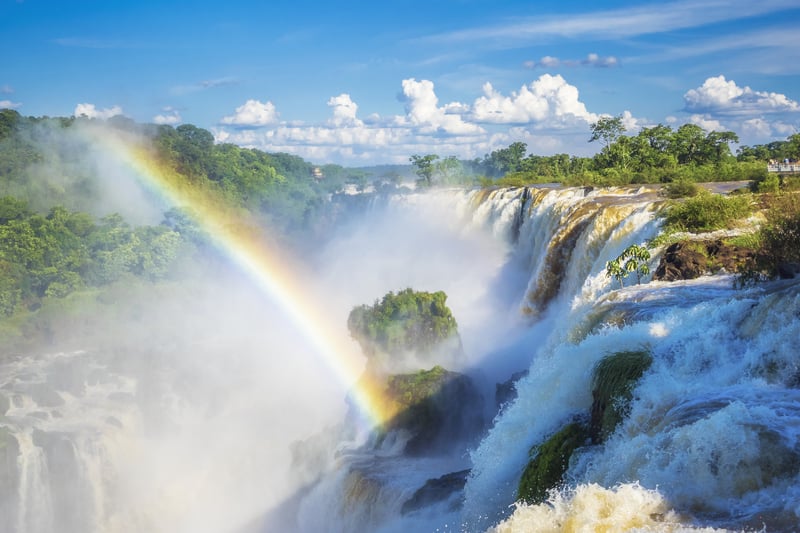
Welcome to another edition of Storylines ultimate world cruise itinerary series. Our growing community of global citizens on board MV Narrative, our private residence ship, has provided a wish list of destinations for us to explore. So far in the series, we have covered:
- Eastern Mediterranean
- Middle East
- Africa
- Asia
- Southeast Asia
- Australia & New Zealand
- South Pacific
- North America
While the exact order of the destinations and sea routes are not yet finalized, the requested destinations in South America are:
- Galapagos
- Machu Picchu
- Valparaiso Chile
- Patagonia
- Cape Horn
- Tierra del Fuego
- Falkland Islands
- South Georgia Island
- Saint Helena Island
- Brazil
- Natural wonders of the world
- Jungles
It’s also important to note that there will also be several unplanned anchorages in remote and off-the-beaten-path spots to explore by Zodiac throughout the South American countries.
South America
 South America is a vast continent consisting of many nations, mainly Spanish Colonies so most speak Spanish, although, Brazilians speak Portuguese. This results from the 1494 Treaty of Tordesillas, a line dividing the "New World," or Latin America. The Portuguese received everything east of the line; Brazil in South America and the Azores, Madeira, and Cape Verde in the Atlantic (all of which we visit in the next leg of our journey). Spain gained the western hemisphere of mainland South America and much of Caribbean South America (Colombia and Venezuela).
South America is a vast continent consisting of many nations, mainly Spanish Colonies so most speak Spanish, although, Brazilians speak Portuguese. This results from the 1494 Treaty of Tordesillas, a line dividing the "New World," or Latin America. The Portuguese received everything east of the line; Brazil in South America and the Azores, Madeira, and Cape Verde in the Atlantic (all of which we visit in the next leg of our journey). Spain gained the western hemisphere of mainland South America and much of Caribbean South America (Colombia and Venezuela).
Then, there's French Guiana which is generally considered part of this region. Like many Colonial worlds, the native population of South American cultures' indigenous languages are extinct today. There will be numerous opportunities to give back to indigenous communities on our travels.
Galapagos
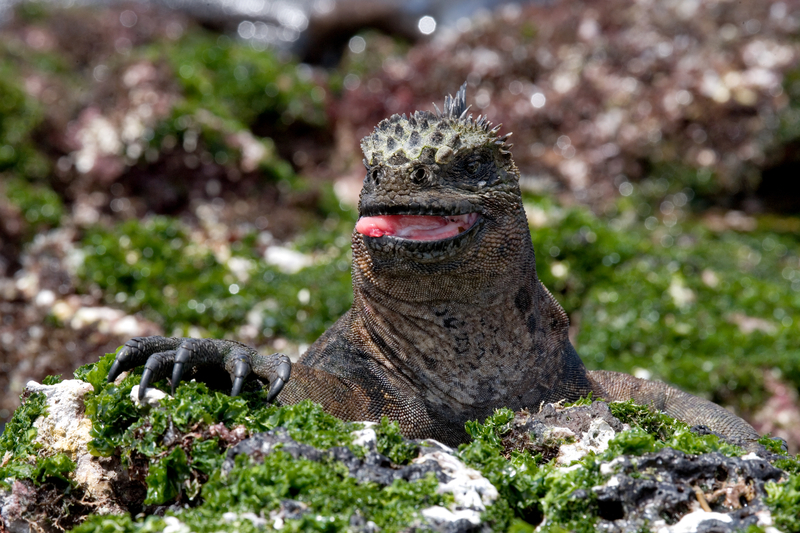
We suspect the Galapagos Islands to be a highlight of the region. Officially a part of Ecuador, they are located 1000 km off its Pacific coast. These volcanic islands are famous for the abundance of unique plant and animal life found nowhere else on earth. Moreover, the Galapagos Islands were also the catalyst for Darwin's theory of evolution and remain fascinating to scientists today.
If we are to dock, it will be in Isla Baltra Galapagos Islands Cruise Port, located near the center of the archipelago. While the island of Baltra contains some of the most fascinating animal species known to man and has a storied history, it does not lie within the boundaries of the Galapagos National Park. As most of the archipelago is a national park, there are only two permitted anchorages; Puerto Ayora and Baquerizo Moreno on the nearby island of Santa Cruz. As a result, we anticipate much of our exploration of the Galapagos Islands to be by Zodiac.
Galapagos must-see:
- Santa Cruz Island: Besides incredible white sand beaches, you can get up close and personal with sea turtles, Sally Lightfoot Crabs, and marine iguanas.
- Giant tortoises: One of the best places to see the famous Galapagos giant tortoise is Rancho Primicias, an animal sanctuary in Santa Cruz.
- San Cristóbal Island: San Cristóbal features several beaches ideal for swimming, snorkeling, and surfing. Head to La Lobería to hang with the island's resident sea lions.
- Snorkeling & Diving: For our resident aquatic enthusiasts, you will find an incredible diversity of wildlife beneath the Galapagos' turquoise waves:
- Wolf Islands' Shark Point (experienced divers only)
- Santa Cruz Islands' Gordon Rocks (experienced divers only)
- Las Grietas on Santa Cruz
- Los Tuneles center of Isabela Island
- Frigatebird Hill at San Cristobal Island
- Bird watching: For our resident bird lovers, you are arguably in the bird-watching capital of the world. The region is home to 45 species of birds you will not see anywhere else on Earth. Keep those binoculars handy!
- Hike Sierra Negra Volcano: For experienced/fit hikers only, this 5.5mile trail begins from the tiny village of Santo Tomas. Prepare accordingly, including plenty of water, as there are no facilities along the route. The reward is a still active volcano and sweeping vistas of the Galapagos.
- Puerto Ayora: As much as Galapagos is all about nature, that doesn't mean you can't enjoy winding down at local restaurants, bars, and low-key nightclubs after a long day's exploration. Puerto Ayora is the place to do just that.
Machu Picchu & Lima, Peru
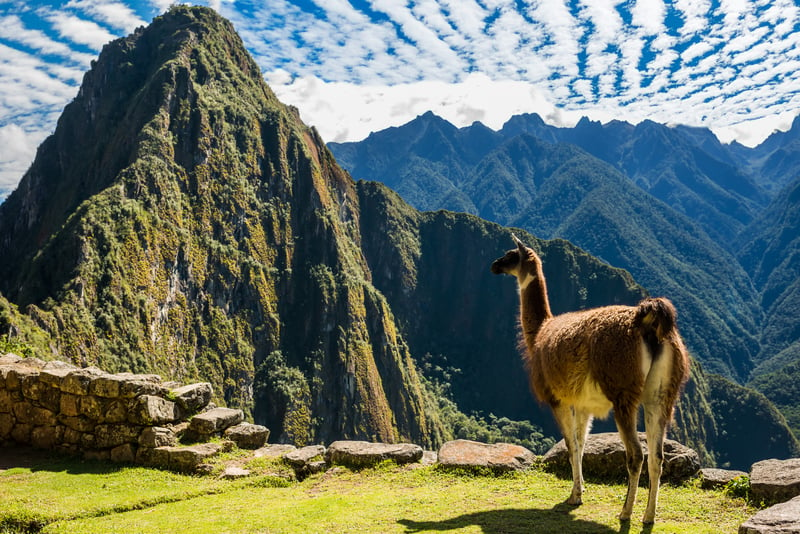 Cruising south from Galapagos down the northern Peruvian coast takes us to Peru's major cities including the capital city of Lima. This serves as the gateway for the requested destination of Machu Picchu. This means that, although Lima was not explicitly requested, it makes sense that we would dock here. And we hope so too because Lima is a great city with some of the finest South American cuisine. As such, this section covers Lima, providing options on how you can see Machu Picchu.
Cruising south from Galapagos down the northern Peruvian coast takes us to Peru's major cities including the capital city of Lima. This serves as the gateway for the requested destination of Machu Picchu. This means that, although Lima was not explicitly requested, it makes sense that we would dock here. And we hope so too because Lima is a great city with some of the finest South American cuisine. As such, this section covers Lima, providing options on how you can see Machu Picchu.
Machu Picchu is one of the world's most famous hiking trails and ancient ruins. It is located in central and northern Peru at the top of the world's most extended mountain range. Cruise ships dock at Cruise Portao, Callao, roughly 14km west of Lima city center. There are buses and taxis ready to take you to Lima. An affordable taxi ride will take you to the historic center, a UNESCO World Heritage site with grand colonial Spanish mansions, beautiful cathedrals, and some Inca ruins. Try to find a taxi driver who speaks some English and charges about $20 per hour.
Lima must-see:
- Plaza de Armas: You must visit this place in central Lima where the city was founded. It is also home to the Government Palace, where the president lives. Changing of the guard happens at 11:45AM.
- Lima Metropolitan Cathedral: While you are in the historical center, check out this incredible work of architecture that took 58 years to complete and was then rebuilt after an earthquake.
- Church & Covenant of San Francisco: It's a miracle that this magnificent building survived two earthquakes. Inside you will find catacombs and a massive 17th-century library full of historical books and other treasures.
- Torre Tagle Palace: Architecture lovers must view the finest example of Spanish colonial style in Lima.
- Stroll Jiron de la Union: Just off Plaza de Armas, a mix of the old and the new architecture, including restaurants, bars, and shops.
- Lima cuisine: There's a reason why Peruvian cuisine has become famous the world over, and it all stems from Lima, now recognized as one of the culinary capitals of the world.
- Casa de Aliaga: One of South America's best-preserved Colonial mansions.
Machu Picchu options:
Firstly, to do Machu Picchu, you must first get to Cusco, the base city where all tours and treks depart. However, this is not so simple, as the Andes Mountains lie between the two cities. If you have limited time at the port in Lima, flying would make the most sense as it's the quickest.
It's important to note that you will fly through the Andes Mountains so you can expect turbulence. Then there's Cusco's rain and stormy weather, which can make for some nervous landings. And just to top it off, Cusco is 10,000 feet above sea level which means you have no time to adjust to the altitude incrementally. As we said, it’s not simple!
Your other option is by bus. As this is longer, you would likely link back up with MV Narrative in Santiago or Buenos Aires. By bus, the climb is more gradual, which allows you to adjust and decrease your risk of altitude sickness. The quickest route is to go through the Andes Mountains, but you must know these roads have a terrible reputation. They are curvy, steep, and dangerous, with a history of incidents.
The safest option is to go around the mountains. It takes twice as long, but it allows even more time to adapt to the altitude. Plus, there's a lot to see on the way, exposing you to the beauty of the Peruvian countryside. Whatever option you decide on, plan your trip to Machu Picchu before reaching Lima. Peru Hop for example takes care of everything, including bus transportation, preparation, and the trek itself.
Valparaiso, Chile
Heading down past Southern Peru now to the long strip of Chile. Valparaiso, The Jewel of the Pacific, is a port city 140km west of the capital, Santiago. Valparaiso, the original world heritage city and one of South America's most historic ports, is known for its distinctive color and cliff-top homes. Its maze of hills and bohemian architecture have long inspired artists, including the famous Chilean poet Pablo Neruda. His former and unique home is now a museum and a must-see. You will find interesting buildings, incredible street art, and some hidden gems by just wandering around.
Ships dock at Valparaiso Cruise Terminal Muelle Prat, within walking distance of town. Alternatively, you can catch a short taxi ride to Vina del Mar, Valparaiso's sister city known as Garden City, one of Chile's premier beach resorts.
Valparaiso must-see:
- La Sebastiana: Chilean Nobel Prize-winning poet Pablo Neruda's former residence and museum is a quirky maze of rooms and offers sweeping views of the port city.
- Sotomayor Square: Valparaiso's grandest square is lined with historical architecture, statues, and the Chilean navy headquarters. You will also find the tourist information center here, which offers maps and walking tours.
- Indulge in Chorrillana: This famous Valparaiso meal is not for vegans; lots of chips stacked with steak, sausage, kebab, caramelized onions, cheese, and a fried egg... maybe it should be called ‘hangover cure’.
- Hotel Brighton: Wander the colorful streets of Concepción, and you will notice a distinctive bright orange house perched on the top of the hill. This is Hotel Brighton, the perfect place for a glass of Chilean wine while watching the spectacular sunset over the Pacific Ocean.
- Parque Cultural de Valparaíso: This former fort turned prison used to torture political prisoners during Pinochet's dictatorship and is now a community art and culture space.
- Santiago: consider a trip to the now thriving capital city of Santiago, a beautiful blend of old historic buildings and modern skyscrapers flanked by the snow-capped mountains.
- Casablanca Valley: Chile has the best South American soil for grape growing. Casablanca Valley is one of many winemaking regions between the Andes and the Pacific Ocean in Chile.
- Valle Nevado: For resident ski lovers, if the season is right you can get some runs in at the most significant and highest ski center in South America, only a half-hour drive east of Santiago.
Patagonia, Chile
 Chile is the most geographically diverse country in the world. It's a long strip of land spanning many climates and ecosystems including mountains, forests, deserts, valleys and glaciers. Nowhere demonstrates this more than Patagonia which also encompasses Argentina; but it's the Chilean side you really want to explore. This is also an excellent opportunity to do a road trip or overland tour. Our Overland Expeditions Worth Leaving Your Boat For blog post covers a possible option. There are several tours available from Santiago (return to Santiago) that include main attractions such as:
Chile is the most geographically diverse country in the world. It's a long strip of land spanning many climates and ecosystems including mountains, forests, deserts, valleys and glaciers. Nowhere demonstrates this more than Patagonia which also encompasses Argentina; but it's the Chilean side you really want to explore. This is also an excellent opportunity to do a road trip or overland tour. Our Overland Expeditions Worth Leaving Your Boat For blog post covers a possible option. There are several tours available from Santiago (return to Santiago) that include main attractions such as:
- Torres del Paine National Park
- Parque Nacional Los Glaciers
- Fitz Roy Mountain
For those feeling adventurous, you can hire a car from Santiago and take a road trip to the world's most southern city of Ushuaia. This is another requested port of call at Tierra del Fuego port, where you can rendezvous with the ship. In this case, you will drive across the border into Argentina. Chile and Argentina are two of the safest countries in Latin America.
Cape Horn

Heading south further still to Southern Chile, we round Cape Horn, the cape of southern South America in the shape of a horn. Hence the name. Next, we’re off to explore the Chilean Fjords. It is possible to cruise into Alberto de Agostini National Park; ice-dependent. Additionally, the following destinations are as close as we will get to the request for North & South Pole penguins. You will be seeing plenty of penguin colonies.
Tierra del Fuego, Argentina
 Tierra del Fuego is the southernmost and least populated province of Argentina. Ships dock in the southernmost city in the world, the port of Ushuaia, the capital of Tierra del Fuego and the Southern Atlantic Islands.
Tierra del Fuego is the southernmost and least populated province of Argentina. Ships dock in the southernmost city in the world, the port of Ushuaia, the capital of Tierra del Fuego and the Southern Atlantic Islands.
You might want to do some sightseeing around the city at the End of the World, and it surprisingly offers excellent shopping due to the island being duty-free. However, we strongly recommend getting out of the city to explore the region by tour or car hire in order to see some of the most incredible nature on Earth. Ushuaia is well-positioned, allowing access to mountains, forests and the icy seas.
The following recommendations are for both Ushuaia and the province of Tierra del Fuego.
Ushuaia and Tierra del Fuego must-see:
- End of the World Museum: Besides telling the fascinating history of the early penal colony and the first Antarctic explorations, you can get your passport stamped for the end of the world!
- Patagonia cuisine: Different from traditional Argentine cuisine, seek out Karma Resto for some unique and unusual yet delicious food.
- Sea Wolves Island: You can book a catamaran tour, or perhaps the ships’ zodiacs can take you across the Beagle Channel to Sea Wolves Island. You’re looking for sea lions, skuas, steamer ducks, and black-browed albatrosses. You will also learn about the history of the SS Monte Cervantes, which sank in 1930.
- Tierra del Fuego National Park: The most southern national park in Argentina features spectacular scenery of mountains, waterfalls, glaciers, lakes, forests, and a magnificent coastline. We recommend taking the famous End of the World Train from the El Parque Station into the national park.
- Hike Martial Glacier: Just outside of Ushuaia, you can trek just below a glacier. It takes about four hours and offers incredible views of the mountains, Ushuaia, and the Beagle Channel.
- Scenic flights: You can take scenic flights over Tierra del Fuego with options available, including landing on top of a snowy mountain.
- Cerro Castor Ski Resort: Resident skiers can carve up some powder near the end of the world with over 26 trails accommodating all skill levels. Roughly 16 miles (26km) from Ushuaia.
Falkland Islands
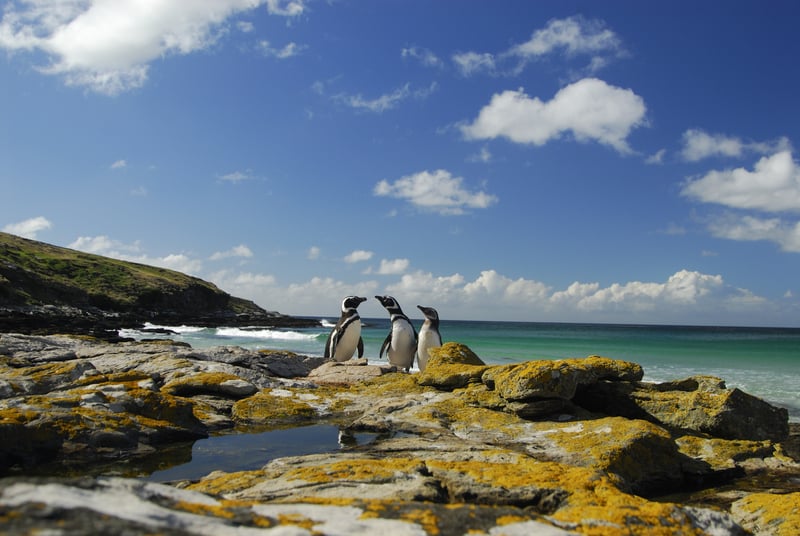 The Falkland Islands, or Isla Malvinas, is an island country in South America. It's an archipelago on the Patagonian shelf in the southern Atlantic ocean about 480 km (300 m) east of Tierra del Fuego in Argentina. It is a British overseas territory and comprises East Falkland, West Falkland, and 776 smaller islands. The islands have a notorious history where competing colonial nations, including the English, French, Spanish and Argentinians claimed the territory. Today, the central dispute over the islands' sovereignty is between Argentina and the United Kingdom. The island's official language is English.
The Falkland Islands, or Isla Malvinas, is an island country in South America. It's an archipelago on the Patagonian shelf in the southern Atlantic ocean about 480 km (300 m) east of Tierra del Fuego in Argentina. It is a British overseas territory and comprises East Falkland, West Falkland, and 776 smaller islands. The islands have a notorious history where competing colonial nations, including the English, French, Spanish and Argentinians claimed the territory. Today, the central dispute over the islands' sovereignty is between Argentina and the United Kingdom. The island's official language is English.
Ships like MV Narrative can anchor near Port Stanley and zodiacs would tender you to shore. The pier is centrally located in Stanley, the capital of the Falkland Islands. Stanley was founded in 1843 and is home to only 1500 people. A must-see is the Falkland Islands Museum, where you can learn about the 1982 Falklands war when Argentine forces invaded the island under British rule.
Falkland Islands must-see:
- Falkland Islands Museum: Besides learning about the conflict, you can view exciting exhibits of the islands' unique flora and fauna.
- Christ Church Cathedral: The southernmost cathedral in the world has a famous arch out the front made from the jawbones of two blue whales.
- Stanley Harbor Maritime History Trail: Before the Panama Canal was completed, all ships had to round Cape Horn, with many succumbing to the notoriously storm-wracked headland.
- Jubilee Villas: Admire these historic British terraced townhouses built in 1887.
- Gypsy Cove: Just four miles from Stanley is this pristine white-sand beach which houses Magellanic penguins, Falklands flightless steamer duck, black-crowned night-herons, oystercatchers, upland and kelp geese, long-tailed meadowlark, two-banded plovers, and the occasional sea lions.
- Bertha's Beach: Another beautiful white sand beach and popular day trip destination, it has Gentoo penguins, unique flora, and fauna.
- Participate in a community event: Get an insight into island life by finding out what's on in Stanley, including dances, crafts, charity shears, and flea markets.
South Georgia Island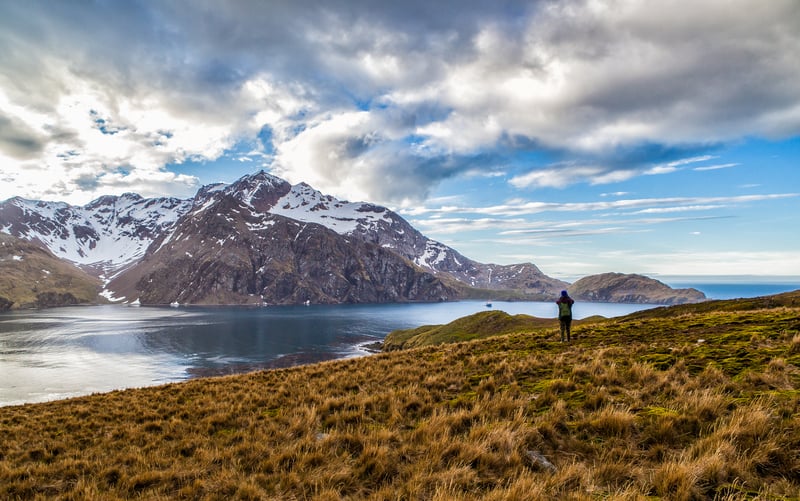
If you're unaware of South Georgia Island, you are not alone! This one is definitely off the beaten track. Located about 800 miles (1290km) east of the Falklands, South Georgia Island and the South Sandwich Islands have no airstrip and are only accessible by ship. Nonetheless, it is one of the most visited islands in Antarctica. And it is spectacularly picturesque, with dramatic mountain-scapes, glaciers, and varied wildlife. However, there are no permanent residents as it's too remote and the terrain inhospitable. Once again, its sovereignty is disputed between the UK and Argentina.
All ships anchor at Grytviken, and you have to tender ashore. A government representative explains the rules and collects a per-passenger fee. There is a museum to learn about the island's history. Besides that, it is all about nature and wildlife.
South Georgia Island must see:
- South Georgia Museum: A former whaling manager's house, the museum explains the island's rich history, from its natural heritage to the lives of its tiny and transient population.
- Shackleton's grave: Ernest Shackleton was a famous explorer who died of a heart attack while exploring Antarctica in 1922. His wife requested that he be buried in Grytviken on South Georgia Island, Shackleton's beloved destination.
- Hike to St. Andrew's Bay: A dramatic landscape of snow-capped mountains surrounding the bay, home to penguin colonies with over 100,000 birds in the wild terrains.
- Hike to Fortuna Bay: This picturesque bay has king penguin colonies and many elephant seals.
Saint Helena island
 Just when you thought we couldn't get any more remote; welcome to St Helena Island, part of a group of volcanic islands in the South Atlantic Ocean known as Tristan da Cunha. They are the most isolated inhabited places on the planet. And one of our residents has requested we visit. Good on you! We love off-the-beaten-path destinations. Tourism only opened here in 2018 so you are possibly visiting one of the most unspoiled places on earth.
Just when you thought we couldn't get any more remote; welcome to St Helena Island, part of a group of volcanic islands in the South Atlantic Ocean known as Tristan da Cunha. They are the most isolated inhabited places on the planet. And one of our residents has requested we visit. Good on you! We love off-the-beaten-path destinations. Tourism only opened here in 2018 so you are possibly visiting one of the most unspoiled places on earth.
There is nowhere that large ships can dock on St. Helena, so we would anchor offshore Edinburgh of the Seven Seas. Yes, that's the name of the main town. As you can probably guess, it's a British overseas territory. And an incredibly scenic one at that. It is one big volcanic island of unusual extremes, including sub-Saharan savannah, ancient rainforest, and... English country gardens!
Isolation is a part of the culture here. It seems St. Helena would be a good place to move to in order to escape humanity, but the truth is the locals, or Saints as they're known, are famous for their warmth and hospitality.
Saint Helena must-see:
- Napoléon's House: Yes, would you believe Napoléon Bonaparte once lived here? He was exiled here in 1815 after the battle of Waterloo. He died of either cancer or poisoning, depending on who you believe.
- Napoléon's Tomb: You can also visit Napoléon's tomb, where he was buried for 19 years before his remains were transported back to Paris. It's a beautiful site.
- Marine life spotting: The waters around Saint Helena are a hive of activity for marine life. One of the best places in the world to spot whales, whale sharks, pantropical spotted dolphins, bottlenose dolphins, rays and turtles.
- Snorkel and dive: Continuing from the previous point, diving here is some of the best in the world, with several reefs, wrecks, and caves to explore. Swimming with whale sharks can be done between December to May.
- Walk around Plantation House: Home to the Governor of St. Helena, there are several walks you can take through the beautiful grounds, and you might bump into the resident tortoise, Jonathan.
- Hike to High Knoll Fort: Set atop a mountain, this fort was built in 1798 to defend against an invasion. It has incredible views.
- Hike the Post Box Walks: Hike to 21 Post Boxes, specific points along island trails where you collect stamps as souvenirs.
- Jamestown: Stroll around this charming town in a tiny valley by the sea. Climb Jacob's Ladder if you dare, 700 steps up one of the steep valley sides.
Brazil

Brazil is a massive country so we will pick three options to highlight including the request for jungles (Amazon) and natural wonders of the world (Iguazu Falls). The national language is Portuguese, but Brazilians are descendants of many cultures. The apparent port stop would be the famous port city of Rio de Janeiro.
Rio de Janeiro
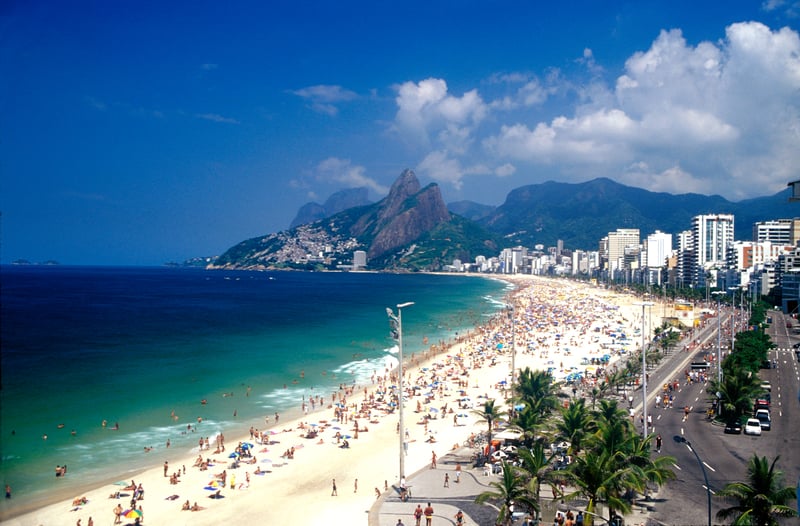 Rio de Janeiro is Brazil's second-largest city after Sao Paulo, with a sizable population of roughly 7 million people. It is one of the most naturally beautiful cities in the world, with magnificent beaches, mountains, and jungles interspersed throughout. However, an enormous wealth gap is evidenced by suburbs full of impressive mansions alongside shanty towns known as favelas. As such, there can be some petty crimes to watch out for, so stay in groups and keep your belongings secure and you'll be fine.
Rio de Janeiro is Brazil's second-largest city after Sao Paulo, with a sizable population of roughly 7 million people. It is one of the most naturally beautiful cities in the world, with magnificent beaches, mountains, and jungles interspersed throughout. However, an enormous wealth gap is evidenced by suburbs full of impressive mansions alongside shanty towns known as favelas. As such, there can be some petty crimes to watch out for, so stay in groups and keep your belongings secure and you'll be fine.
The ship will dock inside Guanabara Bay at Pier Mauá in Rio de Janeiro Harbor. For the 2016 Olympic games, the port underwent a significant renovation, improving the area with a new square, food trucks and other infrastructure. Copacabana is one of the most famous beaches in the world, up there with California's Venice Beach and Sydney's Bondi Beach. However, we prefer Ipanema; it's more chill, prettier and safer.
Rio de Janeiro must see:
- Copacabana Beach: Take a stroll along this famous beach. If the weather permits, have a swim. Just pay one of the lounge chair providers to mind your belongings. You can order beer or caipirinhas from your lounge chair and enjoy the excellent people-watching.
- Christ the Redeemer: One of the most famous statues in the world, up there with the Statue of Liberty, sits atop Corcovado mountain, offering the best views over Rio de Janeiro.
- Sugarloaf Mountain: One of Rio's most recognizable attractions juts 1,299 ft above the harbor. We recommend catching the cable cars up to Sugarloaf at sunset when the city lights flicker to life for the ultimate view of Rio.
- Parque Lage: This magical park sits at the bottom of Corcovado Mountain and features an old, opulent mansion surrounded by exotic gardens and jungle. There is also a hidden aquarium and free art exhibitions on site. For keen (and fit) hikers, this is where the trail starts to climb up to Christ the Redeemer.
- Museum of Modern Art: The museum is worth the visit just to admire the architecture alone. Additionally, the ferry ride from Praça XV and arriving at Niterói- Praça Arariboia is rather pleasant. And then there's the art, of course!
- Ipanema Beach: Ipanema is the next beach around Copacabana. While it's also an urban beach, it has gorgeous mountain views, excellent surf, and beautiful Brazilians... after all, it was made famous by the bossa nova song, The Girl from Ipanema.
- Hang glide over Rio: One of the favorite things this writer has done while in Rio was hang glide off the top of Pedra Bonita Mountain. Besides the incredible adrenalin rush, you get birds-eye views of Rio, including wealthy neighborhoods next door to Favelas. And you land on the beach!
- Casa das Canoas: For architecture lovers, you must visit the former home of famous Brazilian architect Oscar Niemeyer, who designed it in 1951. Surrounded by jungle and integrated into the land, it is a work of art.
Volunteer opportunity in Rio de Janeiro
As previously stated, Brazil has one of the highest wealth gaps in the world. Many youth, particularly in the favelas, turn to crime. Um Rio combats this by using rugby, education, and healthcare to create an enabling environment and a safe space for children and youth in Rio's most vulnerable areas in order to:
- Access and forge new opportunities
- Develop and pursue aspirations
- Build confidence in their own identities
Um Rio works in partnership with the Oxford University Rugby Club. They have numerous volunteer opportunities, including coaching rugby and other sports, and donation programs.
Natural wonders of the world
Iguazu Falls and Iguazu National Park
 Private day-trip Iguazu tours from Rio de Janeiro can take you to either the Argentinian or Brazilian side of the falls. The Iguazu Falls border the two countries, and either side is incredible. They have excellent boardwalks and viewing platforms to experience the largest water system in the world. If possible, fit in a hike at Iguazu National Park where you can see toucans, capybaras, howler monkeys, and, um... jaguars!
Private day-trip Iguazu tours from Rio de Janeiro can take you to either the Argentinian or Brazilian side of the falls. The Iguazu Falls border the two countries, and either side is incredible. They have excellent boardwalks and viewing platforms to experience the largest water system in the world. If possible, fit in a hike at Iguazu National Park where you can see toucans, capybaras, howler monkeys, and, um... jaguars!
Jungle
The Amazon Rainforest
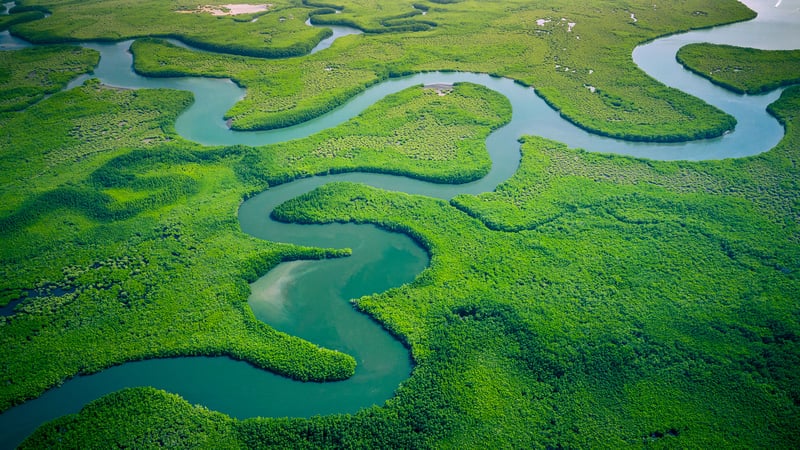 Well, we figure you can't match the request for jungles any better than the largest in the world, The Amazon Rainforest. Manaus, the cruise port city and capital of the Amazonas state, is the base. We are hopeful that it will be possible for MV Narrative to make it up the Amazon River to Manaus.
Well, we figure you can't match the request for jungles any better than the largest in the world, The Amazon Rainforest. Manaus, the cruise port city and capital of the Amazonas state, is the base. We are hopeful that it will be possible for MV Narrative to make it up the Amazon River to Manaus.
The ship would dock at Porto Flutuante, floating docks that rise and fall with river tides. The port is conveniently located within walking distance of the city's main sights. Manaus was once the rubber producer of the world, and the town was built for this purpose. You can see the past wealth from much of the city's architecture. However, we suspect most will want a jungle-guided river tour.
Manaus and Amazon must-see:
- Teatro Amazonas: The opera house is the city's pride and joy; built-in 1896 at the height of the rubber trade, it is simply spectacular. And the inside is even more impressive than the outside.
- Palácio Rio Negro: Another sign of Manaus' past wealth, this aesthetically designed palace was built in 1903 and belonged to German rubber merchant Waldemar Scholz. It is now a cultural center and art gallery.
- Museu do Indio: The Museum of the Indian features more than 3,000 artifacts of indigenous peoples' culture and way of life. Keep in mind there are still tribes living in the Amazon with little to no contact with the outside world.
- Museu da Amazonia: This unique outdoor museum teaches everything about the Amazon flora, fauna, and wildlife. Do not miss climbing the 42-meter tower to view every rainforest canopy layer.
- Bosque da Ciencia (Science Forest): You can meet jungle animals, including otters, monkeys, and manatees.
- Encontro das Aguas: Another natural wonder of the world, the meeting of the waters, is where the light brown muddy water of the Rio Solimões and the dark-colored water of the Rio Negro join to form the Amazon River.
- Anavilhanas Nature Reserve: An archipelago of 400 islands, islets, and flooded forests is an example of the Amazonian ecosystem. Expect to see various birds, including toucans, parrots, woodpeckers, herons, night monkeys, squirrel monkeys, sloths, caimans, turtles, and other reptiles.
- January Ecological Park: Only 45-minutes upriver from Manaus, this 688-hectare of jungle and swampy woodland features giant water lily, Caymans, anacondas, and exotic birdlife.
- Jaú National Forest: The largest protected rainforest area in the world which cannot be logged. It has vibrant fauna and is home to manatees, otters, pink river dolphins, piranhas, and jaguars.
- Amazon tours: Check out Southern Cross Tours and Expeditions for Amazon travel, times, and expeditions.
Thanks for reading, and keep a lookout for our next leg as we head toward the magical Caribbean Sea.
Storylines
Storylines is a luxury lifestyle ship with a like-minded community of globally-conscious citizens traveling the world. We seek unique experiences, cultural events, and community participation while practicing and promoting sustainable travel. To learn more, visit our website.
Disclaimer: The ultimate world cruise itinerary blog post series explores some of the requested destinations of our community of global citizens on board Storylines MV Narrative. It is for inspiration only at this time and the final itinerary has not yet been set. Further information in our FAQ.


